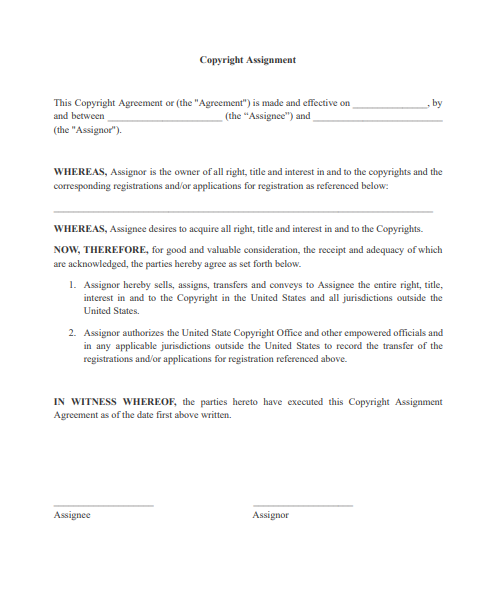Copyright Assignment Forms are used to assign your ownership in a copyright to another party. Assignments can be used for video and written works, as well as works of art and photographs. Your ownership in a copyrighted work is transferred once an assignment is entered into.
A copyright assignment is a legal document that transfers copyright ownership from one party to another. Copyright assignments are typically used when an artist or creator wants to sell or otherwise transfer their copyright to another party, such as a publisher or record label.
The copyright assignment must be in writing and signed by the copyright owner. It should also include a clear statement of the copyright being transferred and the date of the transfer. The assigned copyright should then be registered with the copyright office in order to be valid.
There are three parties involved in a copyright assignment:
- The copyright owner is the person who holds the copyright and is selling or transferring it to the assignee.
- The assignee is the person who is buying or receiving the copyright.
- The copyright office is the government agency responsible for registering copyrights.
Copyright assignments can be used for any type of copyrighted work, including art, music, literature, software, and website content. They are often used when creators want to sell their copyright outright, but can also be used for more limited transfers, such as granting someone the right to publish a work or use it in a film.
A copyright assignment is typically needed when an artist or creator wants to sell or transfer their copyright to another party. This could be for financial reasons, such as when a musician sells the copyright to their song to a record label. Or it could be for creative reasons, such as when an author transfers the copyright to their book to a publisher. In either case, the copyright assignment must be in writing and signed by the copyright owner.
There are many benefits to having a copyright assignment.
- For example, it can help to ensure that the copyright is properly registered and that the assignee has the exclusive right to use the copyrighted work.
- It can also help to prevent disputes between the copyright owner and the assignee down the road.
There are many factors to consider, such as the type of work being assigned, the length of the assignment, and the rights that the assignee will receive.
However, there are also some risks to consider before signing a copyright assignment. For instance, the copyright owner may lose all rights to the work and may not be able to get it back. Additionally, the copyright owner may be giving up their right to sue for infringement.
If you are an artist or creator who is considering selling or transferring your copyright, it is important to understand the process and requirements involved. You should also consult with a qualified copyright attorney to ensure that everything is done correctly and that your rights are fully protected.
A copyright assignment or copyright transfer agreement is a legal document containing provisions for the conveyance of full or partial copyright from the rights owner to another party. It is similar to contracts signed between authors and publishers but does not normally involve the payment of remuneration or royalties. Such agreements are a key element of subscription-based academic publishing and have been said to facilitate the handling of copyright-based permissions in print-only publishing. In the age of electronic communication, the benefits of copyright transfer agreements have been questioned, and while they remain the norm, open licenses as used in open access publishing have been established as an alternative.
Copyright assignment became common in the publishing business after the Copyright Act of 1976 in the United States and similar legislation in other countries redefined copyright as accruing to the author from the moment of creation (rather than publication) of a work. This required publishers to acquire copyrights from the author in order to sell the works or access to it, and written statements signed by the rights owner became necessary in order for the copyright transfer to be considered valid.
The situation in which authors hold the copyright usually involves considerable effort in the form of correspondence and record-keeping and often leads to unnecessary delays. Although this may appear to be trivial for a few requests, a good scholarly journal publishing exciting papers can expect several hundred requests per year; a task of this magnitude can become onerous. On the other hand, if the Journal holds the copyright, requests, value judgments, and permissions can be handled expeditiously to the satisfaction of all concerned.
Granting publishers the permission to copy, display, and distribute the work is necessary for publishers to act as such, and copyright transfer agreements across a wide range of publishers have such provisions. The reach of copyright transfer agreements can go well beyond that, and some publishers require that, to the extent possible, copyright be transferred to them.” This means that no one, including the authors, can reuse text, tables, or figures in other publications without first getting permission from the new copyright owner.
Copyright assignment also ask that the authors confirm to actually own the copyright for all the materials pertaining to a given act of publishing and that the item for which the copyright is to be transferred has not been previously published and is not under consideration to be published elsewhere, to limit the frequency of duplicate publication and plagiarism.
Critics have said that the copyright transfer agreement in commercial scholarly publishing is “as much about ensuring long–term asset management as it is about providing service to the academic community” because the practice seems to grant favor to the publisher in a way that does not obviously benefit the authors. Copyright transfer agreements often conflict with self-archiving practices or appear to do so due to ambiguous language.
Copyright assignmet are one way to govern permissions based on copyright. Since the advent of digital publishing, various commentators have pointed out the benefits of author-retained copyright, and publishers have started to implement it using license agreements, wherein the author of the work retains copyright and gives the publisher the permission (exclusive or not) to reproduce and distribute the work. A third model is the so-called “browse-wrap” or “click-wrap” license model that is becoming more and more popular in the form of the Creative Commons licenses: it allows anyone (including the publisher) to reproduce and distribute the work, with some possible restrictions. Creative Commons licenses are used by many open access journals.
Copyright assignments are usually prepared by the publisher, and some print journals include a copy of the statement in every issue they published.
Related Forms:
Other Forms
- Affidavit Forms
- Assignment Forms
- Attorney Forms
- Bankruptcy Forms
- Bill of Sales Forms
- Borrow, Lend & Collection Forms
- Business Forms
- Confidentially Forms
- Contract Forms
- Copyright Forms
- Corporation Forms
- Credit Form
- Declaration Form
- Deed Forms
- Divorce Forms
- Employment Forms
- Entertainment Contract Forms
- Family Law Forms
- Free Will Forms
- Government Form
- Health Care Forms
- Homestead Form
- Indemnity Agreement Form
- Intellectual Property Forms
- Internet Forms
- Landlord and Tenant Forms
- Lease and Rental Forms
- Letter Forms
- Limited Liability Co. Form
- Non-Compete Forms
- Non-Disclosure Forms
- Notice Forms
- Parental Permission Forms
- Partnership Forms
- Power of Attorney Forms
- Premarital Forms
- Promissory Notes
- Real State Forms
- Release Forms
- Sale & Purchase Forms
- Technology Forms
- Trademarks Forms
- UCC Forms


